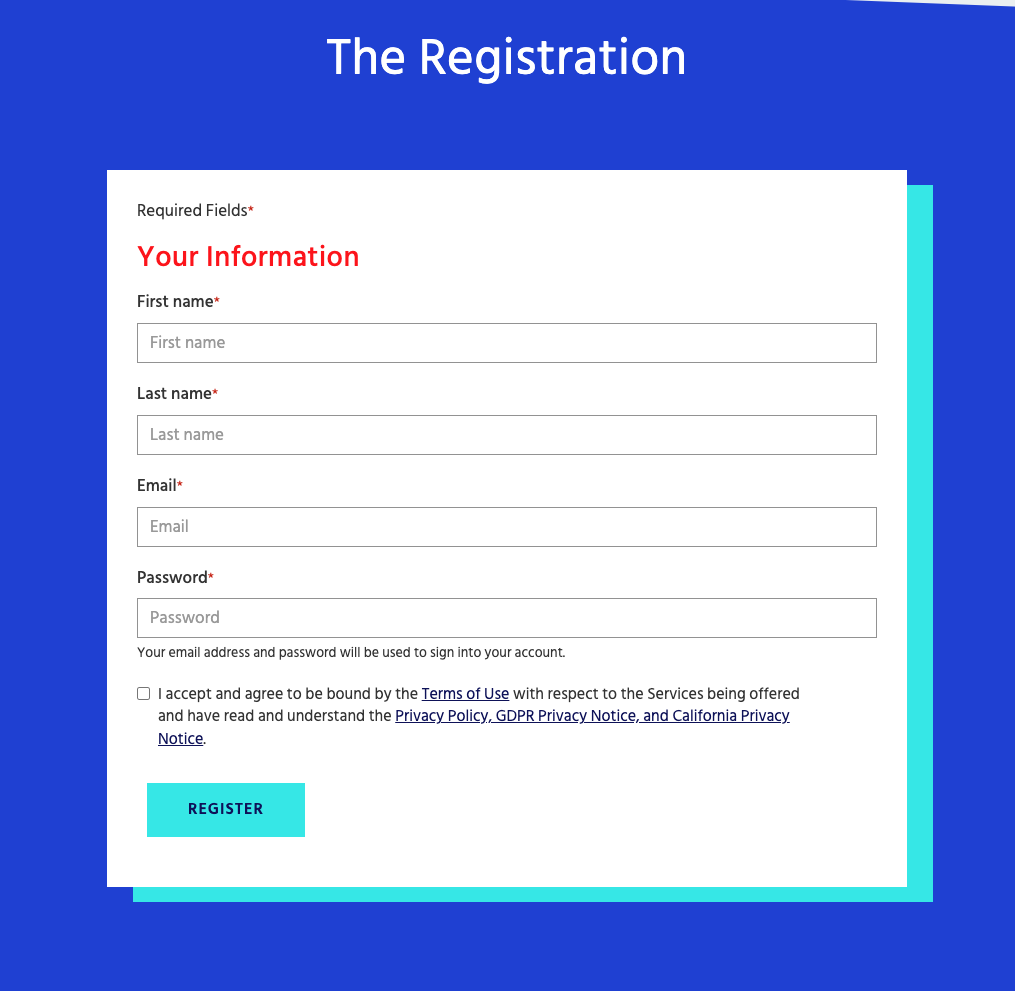When organizing an event, prioritizing a frictionless, successful registration experience will have a positive ripple effect that can be felt through the entire event and beyond. Registering for an event is often the first touchpoint for attendees, and having flexible online registration is paramount to a positive registration experience. However, when it comes to event registration, one size does not fit all. For example, registering for a webinar or an in-house educational seminar differs greatly from the registration process for a multi-day user conference.
Accordingly, your event registration software needs to have the flexibility to accommodate various requirements, whether attendees are requesting a special meal, registering multiple people at once, or indicating accommodation preferences. Your event registration platform of choice may also need to provide the flexibility to create separate, optional add-on sessions such as gala dinners or pre-conference education sessions. Finally, the ability to tie registration to different tracks may be pivotal, so you can easily identify regular attendees, VIPs, or speakers and tailor their experiences accordingly.
Communicating Your Event Registration
The first step in any registration campaign is deciding how you’re going to announce—and then communicate—your upcoming event registration with your audience. It’s important to keep the tone and positioning consistent with other brand communications, so the process often begins by examining the same marketing channels that are already familiar to your audience.
Track Your Marketing Efforts
Take advantage of trackable URLs—also known as UTM parameters—or promo codes to define the success of each of your marketing campaigns. Both trackable URLs and promo codes can be shared with industry influencers, speakers, sponsors, and other collaborators, and will make it easier for you to define the success of your marketing efforts and measure ROI.
Consider The Entire Experience
Poor registration experience is a major contributor to registration drop-offs: when visitors who started the registration process don’t complete it. Consider technical aspects that are more “behind the scenes” but help reduce friction.
For instance, if your audience primarily interacts with your brand on mobile devices rather than on desktop browsers, make sure your registration software allows for mobile-friendly registrations.
Make sure you only ask what is absolutely necessary for your registration process, and use functionalities like conditioning fields and global fields to make it easier for your attendees to complete their registration. Conditional fields will help to ask questions that are only relevant to a certain group of people, and global fields will allow you to pre-fill data about the attendee that you may already have in your event platform, saving your attendee time and making it easier for them to complete the registration.
Make Your Event Website Stand Out
Event websites continue to be an extremely powerful marketing tool for promoting your upcoming events. They provide potential attendees with detailed information about the event while educating them on why they must not miss it.
Ensure that your event registration platform allows you to utilize your branding and messaging so you can keep your brand consistent across all platforms. It’s entirely possible that your potential attendees are visiting your website after they’ve seen the event advertised elsewhere, simply because they want to know more about your event, or because they need one final push before committing to the registration.
Want another great website tip? Don’t forget to complete the look and feel of your website by using professional images from past events. Great photos help to induce FOMO; if you effectively showcase a can’t-miss event, your audience will respond to the additional social proof with increased registrations.
How to Optimize Your Event Registration Strategies and Process
Regardless of its format and content, there’s no event without your attendees! It’s, therefore, crucial to design your event’s onboarding process to be as easy and smooth as possible to encourage registrations. Below are a few pointers on how to optimize your event registration process to encourage a large turnout and make your event as successful as possible.
Encourage Group Registration
For many events, it makes sense to offer streamlined registration for groups, such as companies and organizations. In order for this to work, your event registration app must be flexible enough to handle group categorizations, and an optimized event registration process for groups should match the ease and simplicity of the standard individual registration process. As an extra incentive, it’s a great idea to provide discounts in the form of coupons to encourage group registrations.
Keep Event Registration Forms Concise
Whittle your form down to its essentials and only ask for information that’s pertinent to the event registration. Research has consistently shown that the more pages someone must fill out in a form, the likelier they are to abandon it.
Avoid Repetitive Event Registration Forms
If a common event registration pain point is having to fill out lengthy forms, it’s best practice to avoid making return attendees fill out the same forms more than once. Because if an individual has already attended a previous event from the organizer, why should they have to fill out the same lengthy form again? Your event registration system should be intelligent enough to pre-populate personal information from its database to reduce the frustration that comes with filling out forms.
Place Registration Forms On The Event Website
Many registration platforms take the user from the event website to a third party registration site, which disrupts the user experience and, many times, doesn’t carry the branding forward from the website to the registration. To provide a better user experience and keep control of your brand, consider event registration platforms that can provide a seamless registration experience to your attendees, which can also increase trust.
Ensure Brand Consistency Across Registration Forms and Website
A professional, consistent look between your conference’s website and the online registration form helps potential attendees feel comfortable. If registrants land on a page that looks nothing like the site they came from, they might feel like they are in the wrong place and feel hesitant to complete the form. Keeping a consistent representation of your brand gives your registrant confidence in your organization and your event.
Ensure Registration Forms Work Across Browsers
Whether you are developing your own registration form, using a plug-in, or using online event registration software, you will want to test your form in each of the major browsers. Chrome, Safari, and Firefox are a great start. Every browser is unique, and what looks good or works in one browser may sometimes not work in another. Although most issues are minor, such as alignment or spacing inconsistencies, in some cases your form may not work at all. If registrants can’t complete their enrollment, it reflects poorly on the event and increases the likelihood of losing the registration.
Design a Mobile-Friendly Event Registration Process
With mobile devices taking a 55% market share over desktop devices between January 2021 and January 2022 according to Statcounter, it is more important than ever to ensure that the online registration process is mobile-friendly. This means that your conference’s registration should be accessible not only from a desktop computer, but also from any tablet or phone. By taking this step, you offer your registrants the convenience of registering immediately from wherever they happen to be.
Prioritize User-Friendly Payments
With e-commerce becoming increasingly common, attendees expect to be able to pay for tickets digitally without hassle. If your event management software supports customizable registration forms, you can make the online payment process as simple as possible for attendees. Plus, integrated payment solutions not only begin to create a positive attendee experience, but they also save you time and administrative headaches.
Offer a choice of secure payment processing methods and the ability to choose different event pass types at various price points, i.e. single-day tickets versus 3-day passes. Providing a variety of ticketing options, accommodating discounts and refunds, and offering promotional codes take the guesswork out of the process for attendees and can also allow more people to attend your event.
If you host international events, consider a platform that can accept payments in multiple currencies.
4 Easy Tips to Drive Your Registration Further
1. Remarketing Can Boost Registration By 20%
Incomplete registrants—the people who have stalled midway through your event registration process—are an often-overlooked source of additional event attendees. A study conducted by the Baymard Institute found that e-commerce transaction abandonment rates averaged almost 70%, with some studies reporting rates up to 84%. That’s a lot of lost registrations!
Event registration case studies (including this one by the RFID Journal) have shown that, with a solid remarketing campaign, you can gain back 20% or more of your event registrations that have stalled somewhere along the way. That’s 6% of your overall registration total. With some thoughtful target marketing and a series of strategic email campaigns, you can boost attendance to your event and increase your revenues significantly.
Using the registration module of your event technology platform, you should be able to compile a comprehensive report that will identify all of the partially completed or incomplete registration forms. Then, set up a series of automated yet personalized emails to go out to these people who have abandoned their registration process, regardless of where in the funnel they dropped out.
If you think it might apply, you can also include some reassuring language to your event’s legal policy or terms and conditions. The tone should be friendly and lighthearted. Here are some great examples of effective emails to inspire you.
Registration abandonment emails typically have much higher click-to-open and open rates than usual. This is because the prospective attendees are already familiar with the event and just need a little reminder or encouragement to complete their registration form. By creating an email campaign filled with engaging event content, keynote speaker highlights, or even a discount for prospective attendees, you can increase your event registration revenues considerably.
2. Be Proactive and Catch Problems Early
Sometimes people drop out of the registration process due to design flaws in your event registration forms. Most people will not take the time to tell you that they experienced a problem, so be proactive: take the time to double-check and test all scenarios before launching your forms to the public.
3. Schedule and Send Event Registration Reminders
If your event invitation contains an early bird discount, you can use the upcoming deadline as a reason to send another email reminder to your incomplete or abandoned registrants. Make sure you send it at least a few days, if not a week, before the deadline to give them adequate time to take advantage of the opportunity. Sending another one the day before the deadline is not taboo either. Remember, these are people who have already shown interest in your event. They just need a little nudge!
4. Utilize Valuable Post-Event Data
The registration process can yield some valuable attendee data. But tracking, storing, analyzing, and effectively utilizing the volume of event data for all your events is no small feat. Thankfully, sophisticated event planning software like EventUp Planner can simplify the task by integrating with marketing automation tools (HubSpot), marketing analytics software (Marketo), CRM solutions (Salesforce), and email marketing tools (MailChimp, Infusionsoft). By integrating your event registration software with your marketing tech stack, you can send automated follow-up emails after registration to ensure attendees are consistently engaged, garner value from post-registration survey data, and export reports that track performance through the entire event lifecycle, from registration through post-event follow-up.

Technology to Support Your Event Registration Strategies
We’ve spent a lot of time discussing how flexible event registration software needs to be to accomplish a successful event in today’s market, and just how many pain points there can be if you haven’t yet discovered a solution.
EventUp Planner is a powerful event registration platform that simplifies the management of the meetings and events that your organization relies on. From digital marketing and registration to speakers, attendees, rooms and sponsors, EventUp Planner simplifies the complexity of event registration.
Our built-in templates and drag-and-drop interface enable your teams to quickly build and launch event websites, registration, and communication flows that are on-brand and look amazing.
Here are a few features of EventUp Planner (formerly Attendease) that will support you with your event registration strategies:
- Design white-labeled, fully branded event websites
- Create branded email templates for every event
- Design a custom event app
- Easily handle different registration types and waitlists
- Manage pricing categories, promo codes, and group passes
- Manage secure payments with Stripe, Microsoft, Apple and/or Google Pay
- Create unique registration forms for specific pass types
- Save registration forms to use again in future meetings and events
- Keep attendees up-to-date through our mobile event app
- Track and measure your event performance
Want to learn more about EventUp Planner and how it can help you streamline your event registration strategies? Book a demo today!

